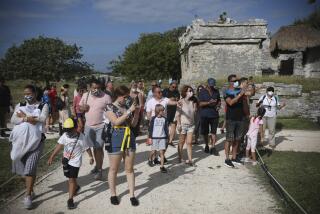Croc Tamer Snags Tourists
- Share via
IXTAPA, Mexico — Like a lot of people in Mexico, Erroberto Piza Rios likes to kick a soccer ball around. He just does it in a very rough neighborhood.
When tourists stop by, Piza dons the yellow jersey of his favorite team, America, and plays with his crocodiles -- who are named for former players.
“Header, Biyik!” he shouts, kicking the ball off the head of a large but immobile crocodile. “Very good.
“Now you, Zamorano. Show how you control the ball!” Piza says, setting the ball on the head of a 660-pound crocodile, which raises its head, letting the ball roll down its back to its tail.
Piza says he’s tamed 47 crocodiles over the last 24 years on an inlet at Playa Linda, a beach in the Ixtapa resort area on Mexico’s Pacific coast -- a region whose inlets and lagoons are noted for crocodiles.
“I’m the king of the crocodiles!” he tells a group of tourists before bellowing out a Tarzan-style cry.
His long, gray hair held back by a headband, Piza offers one of the more eccentric tourism operations in the region.
He reclines on the backs of some of his charges, scratches their bellies, even kisses some of the smaller ones. And he feeds them.
“Was the fish good?” he asks a crocodile that raises its neck so that Piza can scratch it as 20 other reptiles keep their distance.
Piza says he’s always gotten along well with creatures that make other people flee.
“I have that gift of speaking with the crocodiles because since I was a boy, I’ve had the habit of getting along with scorpions, snakes, spiders and tarantulas, and I’ve never been attacked by those animals,” he said. “Now my crocodiles let me earn a living.”
Because Piza holds his shows on public property, he says he can’t charge tourists for watching him frolic with the crocodiles. But he asks for donations from passers-by.
As part of another attraction, he pulls a small crocodile -- about 4 feet long -- from a plastic bag and lets it gently bite his face and arm. He allows tourists to have their pictures taken with the creature for 20 to 40 pesos, or about $2 to $4.
Piza says he carries the reptiles about when they are very young, then releases them into a tidal creek at Playa Linda when they are too heavy.
The crocodiles don’t have many such friends. Piza says the reptiles’ population has declined sharply in recent decades as hotels, golf courses, highways and hotels have spread along the once-wild coast.
About half of the areas where crocodiles lived 30 years ago have been built up, says veterinarian Sergio Enriquez Arcaraz, head of the National Resources and Wildlife Department at the federal environmental agency. He says the agency hasn’t done any studies to estimate the total number of crocodiles in the area.
Enriquez says recent crocodile attacks on a few people in the area drew attention to the reduced habitat, prompting formation of a Commission for the Protection and Conservation of the Crocodile. One of the commission’s tasks is to determine if some crocodiles should be moved from areas where they might come into conflict with humans, to head off calls for them to be exterminated.
On May 22, a reportedly senile woman was killed when she stumbled into an inlet where about 100 crocodiles live.
But crocodiles are not always cooperative with relocation efforts.
“The crocodiles are territorial and many of them, although they are relocated far from their places of origin, return to where they were born,” Enriquez said.
“Now a lot of hotels and restaurants have problems because the crocodiles have returned five or 10 years after they were removed from their original territory.”
More to Read
Sign up for The Wild
We’ll help you find the best places to hike, bike and run, as well as the perfect silent spots for meditation and yoga.
You may occasionally receive promotional content from the Los Angeles Times.






